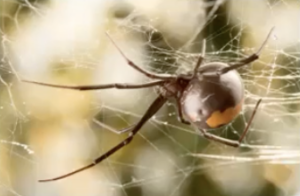BGU: Invasive brown widow spiders host novel bacteria related to chlamydia

Invasive brown widow spiders across three continents were highly infected with a single strain of Rhabdochlamydia, a bacterium that is related to major pathogens of humans and animals, including chlamydia. A bite from these spiders, however, will not infect people with chlamydia. Up until now, Rhabdochlamydia was found in only a few organisms – a tick, an isopod, a cockroach, and one other spider – and even then, was a rare occurrence in all these organisms.
Dr. Monica Mowery and colleagues at Ben-Gurion University of the Negev compared microbial communities in populations of brown widow spiders collected in South Africa (the likely native range of the spider) and invasive populations in Israel and the United States. The overwhelmingly predominant bacteria, Rhabdochlamydia, was found in 86% of spiders surveyed. It was also found in the female spider’s eggs, indicating that mother spiders transmit the bacteria to their offspring.
“Our results suggest that this dominant, widely prevalent chlamydial bacteria has an important role in the invasive brown widow spider,” explained Dr. Monica Mowery, an assistant professor at the City University of New York and a former post-doctoral researcher at BGU.
Characterizing potentially important and widespread bacterial symbionts is a step towards understanding their relevance to ecological interactions and responses to rapid environmental changes. The high prevalence of Rhabdochlamydia in all spider populations tested suggests it may have an important functional role and could contribute to the spider’s invasion success.
The brown widow spider, Latrodectus geometricus, is an urban invasive species that outcompetes native spider species found in warm climates worldwide. These spiders have neurotoxic venom and can be dangerous to young children and the elderly.
Microbial associates can influence a species’ invasive spread and success in a new environment and can shift or be lost during the invasion process. The South African brown widow spiders had overall more distinct strains of bacteria compared to newer arrivals in Israel, where brown widows were first found in Tel Aviv in 1980 and in the United States, where spiders expanded from southern Florida in the 2000s. This higher microbial diversity supports the idea that the invasive brown widow spider originated in southern Africa.
Additional researchers included Prof. Yael Lubin and Prof. Michal Segoli from Ben-Gurion University of the Negev, Prof. Jennifer White, Dr. Eric Chapman, and Laura Rosenwald from the University of Kentucky, Thembile Khoza from the South African National Biodiversity Institute, and Robin Lyle from the Agricultural Research Council, South Africa.
Funding was provided by a Zuckerman STEM Postdoctoral fellowship to Dr. Monica Mowery and by a National Science Foundation grant to Prof. Jennifer White.
About BGU: Ben-Gurion University of the Negev embraces the endless potential we have as individuals and as a commonality to adapt and to thrive in changing environments. Inspired by our location in the desert, we aim to discover, to create, and to develop solutions to dynamic challenges, to pose questions that have yet to be asked, and to push beyond the boundaries of the commonly accepted and possible. We are proud to be a central force for inclusion, diversity and innovation in Israel, and we strive to extend the Negev’s potential and our entrepreneurial spirit throughout the world. For example, the multi-disciplinary School for Sustainability and Climate Change at BGU leverages over 50 years of expertise on living and thriving in the desert into scalable solutions for people everywhere.





